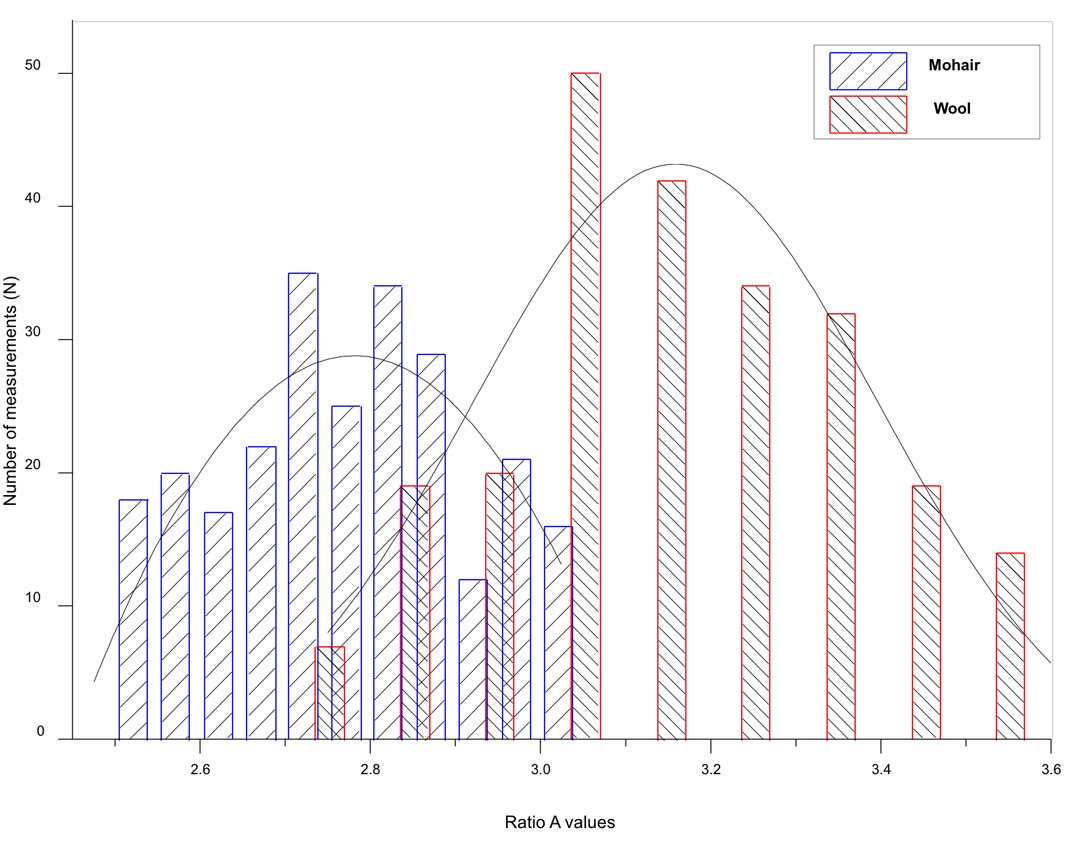The Application of Raman Spectroscopy for Distinguishing Between Mohair and Wool
INTRODUCTION
South Africa accounts for some 50% of the global production of mohair, our product being regarded as the best in the world.
Mohair is renowned for its outstanding quality characteristics, notably excellent lustre, resilience, wrinkle resistance and recovery, durability, moisture management and comfort, and low flammability.
This has resulted in a positive or superior image and prestige being associated with products having the label ‘mohair’, even more so ‘Cape or South African mohair’, and for which discerning traders and consumers are generally prepared to pay a premium.
This positive image, together with the associated premium price, has resulted in mohair being blended with other natural and/or man-made fibres to gain a price advantage and often also having the best of both worlds, this being clearly indicated on the product label.
Nevertheless, for similar reasons, certain unscrupulous operators undertake such blending with other animal fibres, such as lustre wool, but then trade illegally and label the frequently inferior product as pure mohair, thereby unfairly riding on the back of the positive reputation and image of mohair.
Because of the damage (financial losses, prestige, image, reputation) caused by such illegal practices to mohair growers, traders, processors and textile manufacturers, considerable research has been devoted towards developing methods that can reliably distinguish between different animal fibres such as mohair and lustre wool.
The one which is presently internationally the most widely accepted is based on the differences in scale height between mohair and wool (Fig 1), as measured by means of a Scanning Electron Microscope (SEM) at magnifications around 25 000.
Fig 1: SEM images of wool (top) and mohair (bottom) with their close-up SEM images showing the scale height measurements (right) (adapted from Notayi, 2014).
However, the SEM method is time-consuming and expensive. It requires a considerable amount of experience and proficiency by an appropriately skilled operator. Such a test typically costs around R4 000 to R5 000 in certified overseas laboratories and requires highly sophisticated instrumentation.
This has led to other potential methods to be researched, including mitochondrial DNA and lipid and amino acid (protein) analysis.
However, these also have certain drawbacks, such as complexity, cost and lack of accuracy, and none have yet received international acceptance. The SEM method is still the only internationally accepted method.
Because of the above consideration, it was considered essential to search for a less complicated and expensive method that is preferably automated.
To this end, attention was turned to spectroscopic techniques, such as RAMAN/FTIR-based analysis, due to their ease of sample preparation, speed and semi-automatic nature and their sensitivity to any differences in the chemical nature of polymers, such as wool and mohair.
The theory of Raman spectroscopy and its basic principles are explained in the book Handbook of Raman Spectroscopy (Lewis and Edwards, 2001).
EXPERIMENTAL
Materials
Approximately 50 commercially scoured pure wool from various sheep breeds (Lincoln, Romney, Buenos Aires, Corriedale, Merino and Merino-related breeds) and 50 scoured pure mohair samples from different parts of the world (Argentina, USA - Texas, Lesotho, Turkey and South Africa) have been sourced via the Council for Scientific and Industrial Research (CSIR) in Port Elizabeth for use in this study.
Method
Raman spectra were collected on a Bruker RAM II FT-Raman-Module (see Fig 2). This instrument is operated at room temperature and uses a calcium fluoride beam-splitter. It is also equipped with an Nd: YAG laser, emitting at a wavelength of 1064nm, for excitation. All spectra were recorded using a laser power of 500mW, 2 000 scans (equivalent to one hour acquisition time) with a spectral resolution of 4cm-1 being used throughout this investigation, which produced consistent spectra of good quality.
The spectra were acquired and processed using OPUS 7.2 and Origin Lab 8.1 software packages. The spectral region of between 50 to 3 500cm-1 was selected for this investigation. No special sample preparation was involved, with 2mm thick bundles of approximately parallel fibres being inserted in the sample compartment (shown by the arrow in Fig 2) for spectral acquisition.
Fig 2: Bruker FTIR/Raman spectrophotometer at the Nelson Mandela University (NMU).
RESULTS AND DISCUSSION
The FT Raman spectroscopic analysis proved once again that wool and mohair share a very similar basic chemistry, with no particular spectral feature being specific to only one fibre type (see Fig 3).
Fig 3: Typical Raman spectra of wool (blue) and mohair (red).
Minor Raman shifts in peak positions were observed, but were generally neither sufficient nor consistent enough to distinguish between mohair and wool as none of these shifts were consistently distinct (specific) to either fibre.
In the light of the great similarity between the wool and mohair spectra, it was decided to investigate the potential of distinguishing between the two fibretypes using ratiometric analysis based on the Raman band peak heightsof themostprominent bands.For each spectrum, eight peak height measurements were made,namely I2932(CH2asymmetricstretch), I1655(Amide I), I1450(CH2 & CH3bending modes), I1004(Phe & Trp),I936(Skeletal C-C stretch), I644(Tyr), I622(Phe), I508(disulphide S-S stretch).
After initial assessments, the FT Raman band relative intensity ratios A (I2932/I1450), B (I1655/I1450), C (I1004/I1450), D (I508/I1450) E (I936/I1450), F (I644/I1450) and G (I622/I1450) were selected as possibly having potential for distinguishing between wool and mohair (Table 1)
Table 1: Selected Raman band ratios for wool and mohair
A comparison of the means of the various band peak height ratios (Table 1) showed that they all differed statistically significantly (p˂0.05),except for Ratio E (I936/I1450). Nevertheless, the individual values of the two fibres overlapped a great deal, making it difficult to accurately and consistently identify on a qualitative basis individual samples as being either wool or mohair or their blend, let alone on a quantitative basis.However, two of these ratios (A and D) showed a certain potential for detecting the presence of wool in a supposedly 100% mohair sample or product (see Figs4 and 5)
Fig 4: Distribution of the individual Ratio A values for mohair and wool.
Fig 4 shows that all the mohair Ratio A values fall below 3.1, while the wool mostly has above 3.1. What Fig 4, therefore, indicates is that if a sample of unknown fibre identity has a Ratio A value above 3.1, it cannot be pure mohair.
Similarly, if the sample has a Ratio A value below 2.7 it can be safely assumed to be pure mohair.
Between these two values is a grey area, since a sample with a Ratio A between 2.7 and 3.1 could be either wool or mohair, or a blend of the two.
Fig 5: Distribution of the individual Ratio D values for mohair and mohair.
Similar to the above, an analysis of the individual Ratio D results (Fig 5) indicates that a threshold of 0.22 can be used to decide whether a sample is pure mohair or not. If, for example, the sample has a Ratio D value exceeding 0.22, there is a very large probability that it contains no mohair and is pure wool, while if the unknown sample has a Ratio D value below 0.22, it could be either wool or mohair, or a blend of the two fibres.
It can therefore be concluded that, except in the above cases, Raman spectroscopy cannot with certainty distinguish between wool and mohair. This becomes even more difficult when a blended sample is being analysed.
A Raman spectral library of approximately 100 high-quality spectra for the Bruker Ram II system has been created for wool and mohair and can be used in future research. This spectral library has been partially validated in that about 80% of a new (different) set of samples were correctly identified as being either wool or mohair, as the case maybe.
RESEARCH OUTPUTS
A poster paper was presented at the 51st South African Microscopy Conference held in Pretoria in 2013, as well as at the International Mohair Forum held in Jansenville (2013).
A comprehensive Literature Review, covering some 200 scientific and technical papers, formed part of a PhD thesis, the degree being successfully completed, and the student graduating with a PhD (textile science) degree at the April 2021 virtual graduation ceremony of the Nelson Mandela University.
A paper, to be submitted to an internationally refereed journal, is in its final stage of preparation and will be tabled prior to the RAC meeting in September.
In the light of the great similarity between the wool and mohair spectra, it was decided to investigate the potential of distinguishing between the two fibre types using ratiometric analysis based on the Raman band peak heights of the most prominent bands.
For each spectrum, eight peak height measurements were made, namely I2932 (CH2 asymmetric stretch), I1655 (Amide I), I1450 (CH2 & CH3 bending modes), I1004 (Phe & Trp), I936 (Skeletal C-C stretch), I644 (Tyr), I622 (Phe), I508 (disulphide S-S stretch).
After initial assessments, the FT Raman band relative intensity ratios A (I2932/I1450), B (I1655/I1450), C (I1004/I1450), D (I508/I1450) E (I936/I1450), F (I644/I1450) and G (I622/I1450) were selected as possibly having potential for distinguishing between wool and mohair (Table 1).







